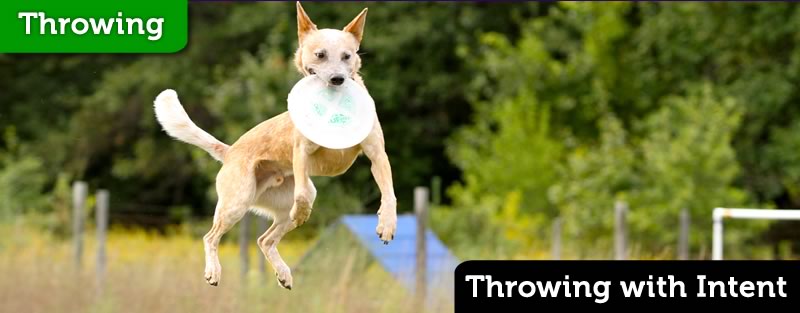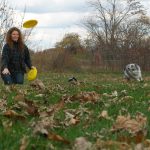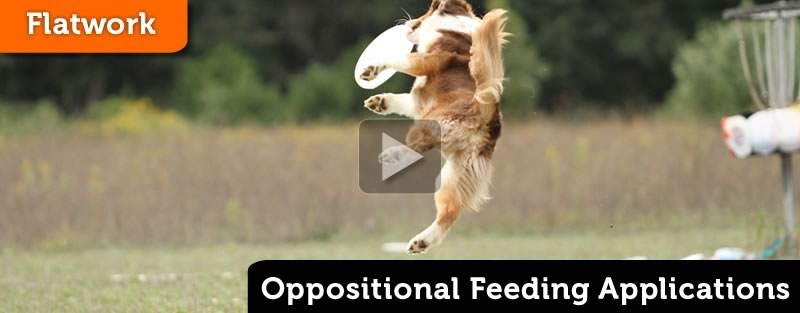
Oppositional Feeding for a Distance Flip
another use for Oppositional Feeding is the creation of a distance flip. slow down and/or stop the dog and create the flip using Reward Placement for the cued Drop.
Simple Theory
Use Reward Placement and Repetition to slow the dog down then Reward Placement for the Flip
Practical
You will cue the Drop and reinforce behind the dog use to create a slow, calculating approach or even a stop. Once the dog is moving slow enough, or in a stable position you will deliver a floater over the dog’s Strong Flipping shoulder. That’s it.
Slowing some dogs down is not easy. It may take many, many reps of the oppositional feed to get your dog to slow down enough for the flip. It may take more than one session. Loot has had several Oppositional Feeding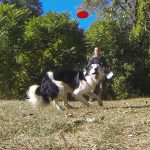 Oppositional Feeding is the opposite of Directional Feeding. The handler throws a disc in the opposite direction that the dog is moving. Oppositional Feeding is a flatwork and training technique used to slow... More sessions geared towards slowing him down. He’s seen the distance flip before too.
Oppositional Feeding is the opposite of Directional Feeding. The handler throws a disc in the opposite direction that the dog is moving. Oppositional Feeding is a flatwork and training technique used to slow... More sessions geared towards slowing him down. He’s seen the distance flip before too.
You might want to work some other patterns that have repetitive throws without a retrieve until you get your dog to slow down enough. Zig Zag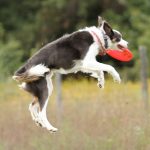 A Zig Zag is a series of catches in smooth succession that forces the dog to move back and forth across the field. Usually performed at a distance of 8-20 yards, the Zig... More and Around the World
A Zig Zag is a series of catches in smooth succession that forces the dog to move back and forth across the field. Usually performed at a distance of 8-20 yards, the Zig... More and Around the World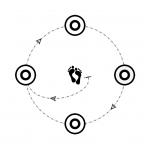 An Around the World is a disc dog flatwork pattern consisting of 4 catches in a circular pattern around the handler. This pattern is typically larger than 5 yards and often features creative... More are good supplemental patterns for slowing your dog down.
An Around the World is a disc dog flatwork pattern consisting of 4 catches in a circular pattern around the handler. This pattern is typically larger than 5 yards and often features creative... More are good supplemental patterns for slowing your dog down.
You might also want to play at half speed and/or not allow your dog to rush you.
Placement & Timing for Slowing Down
MarkShort for “Positive Marker”, a Mark is a word or signal given at the exact moment a desired behavior is performed. It’s like a clicker. Mark can also mean the act of marking... More the cued Drop and get your toss out rather quickly. Don’t rush, but don’t dally either. “Cue Drop = Throw back behind me,” is what your dog should get from this lesson.
The throw is not made so the dog can get it. It’s made so the dog realizes that sprinting towards you or sprinting out of the cued Drop is not going to work, “Perhaps I should pay attention after I get the Drop cue.”
Do not throw directly at or directly above your retrieving dog’s head at speed. This is unsafe. Throw 1-2 yards to the left or right of your dog’s head where they cannot possibly flip for it. Only after your dog has slowed down will you put the disc over their head for the distance flip or Oppositional Feed.
So throw it well behind the dog, a yard or 2 outside of their head on the Retrieve. It should be a major challenge to make the catch. This excitement can be used to pay the cued Drop and to reinforce a slower or more thoughtful approach using Reward PlacementThe dog puts his face where the Cookie or the disc happens. Where you put the reward matters. Reward Placement is huge in disc dog freestyle. Your dog’s face will always wind up... More.
You’ll notice that Loot catches some of the discs thrown behind him, They are a challenge and reinforcing. You can throw further and make the dog miss on purpose – I often start there, but remember that you are reinforcing a slow and thoughtful approach.
Be careful that you don’t pattern train another super aggressive, super fast pattern. I’ve seen this become a manic circle in front of the handler at 12-25 yards. Randomize your timing and placement to discourage unwanted patterns.
Placement and Timing for the Flip
Once the dog is stopping (or drifting slowly) 4-10 yards from the handler go ahead and offer your toss to their Strong Flip side at maximum leaping height. You can try the other side if you want. It’s definitely a different skill at a distance…
Remember that your dog, when standing up, is probably 30-36″ tall. They essentially stand before flipping, so your disc needs to be at least 36-48″ off the ground for even the smallish leaping dog to flip properly.
You must be able to place the target 95% of the time to within a few inches of “the spot” to do this safely. Perhaps a Precision & Accuracy Drill?
[/alert]
Try some different approaches from your dog – work different angles. Some dogs flip quite well out of the Flank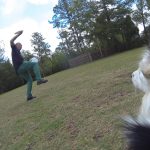 Out to the side of the handler is the Flank. If the dog is out to the handler's right or left the dog is on Flank. If the dog is moving with the... More. Flipping AroundAn Around, or a Go Around is the traditional disc dog set up move. The dog goes around the handler’s body in a clockwise or counter clockwise fashion allowing dog and handler to... More the Worlds are pretty cool.
Out to the side of the handler is the Flank. If the dog is out to the handler's right or left the dog is on Flank. If the dog is moving with the... More. Flipping AroundAn Around, or a Go Around is the traditional disc dog set up move. The dog goes around the handler’s body in a clockwise or counter clockwise fashion allowing dog and handler to... More the Worlds are pretty cool.







